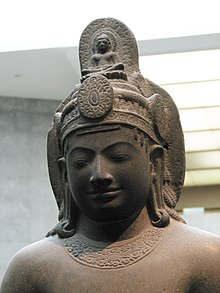เจ้าอยู่หัว
Appearance
(Redirected from พระเจ้าอยู่หัว)
Thai
[edit]

Etymology
[edit]From เจ้า (jâao, “chief, lord, master; god; priest; royal person; etc”) + อยู่ (yùu, “to be at, in, on, etc; to remain, to stay; etc”) + หัว (hǔua, “head”); literally meaning:
- (a) "lord above [all/our/my] head[s]",
- (b) "lord at [all/our/my] head[s]", or
- (c) "[one with] lord on the head".
The suggested meaning (c) is based on the traditional belief that a future Buddha has a figure of Lord Buddha upon his/her head.
Pronunciation
[edit]| Orthographic | เจ้าอยู่หัว e t͡ɕ ˆ ā ɒ y ū ˋ h ạ w | |
|---|---|---|
| Phonemic | จ้าว-หฺยู่-หัว t͡ɕ ˆ ā w – h ̥ y ū ˋ – h ạ w | |
| Romanization | Paiboon | jâao-yùu-hǔua |
| Royal Institute | chao-yu-hua | |
| (standard) IPA(key) | /t͡ɕaːw˥˩.juː˨˩.hua̯˩˩˦/(R) | |
Noun
[edit]เจ้าอยู่หัว • (jâao-yùu-hǔua)
- (พระ~, สมเด็จพระ~, พระบาทสมเด็จพระ~) an honorific for or term of address to a monarch, archaically applicable to high-ranking royal persons also.
Usage notes
[edit]- In modern usage, the term is preceded by พระบาทสมเด็จพระ (prá-bàat-sǒm-dèt-prá) when applied to a monarch who has been formally crowned, and by สมเด็จพระ (sǒm-dèt-prá) when applied to a monarch that has not or not yet been formally crowned.
